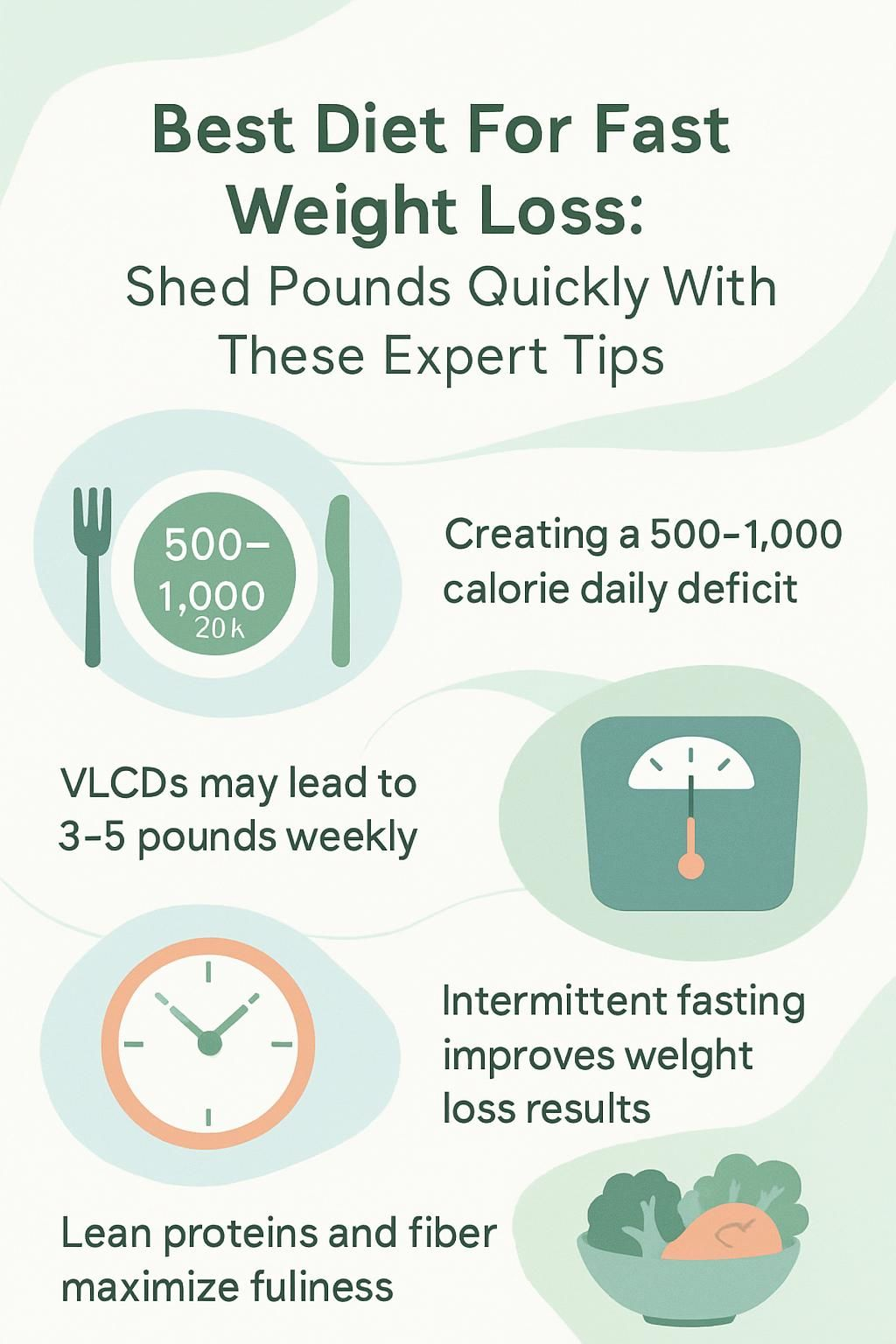Best Diet For Fast Weight Loss: Shed Pounds Quickly With These Expert Tips
Our Nutrition Assistant AI Suite will transform your body. You will lose fat, get toned, and build muscle. Gain confidence and optimal health.
Trying to lose weight fast can feel confusing. You want a diet that works, protects your health, and fits real life. Rapid weight loss usually means dropping more than 2 pounds per week through a tight calorie plan.
This guide shows you how to set a safe calorie target, pick filling foods, and use tools like intermittent fasting or a low-calorie diet. You will learn what works, what to watch, and how to keep the results. Use these tips to choose a plan that helps you lose weight without risking your health.
Key Takeaways
- Creating a calorie deficit of 500 to 1,000 calories per day with low-calorie diets, about 1,200 to 1,500 for most women and 1,500 to 1,800 for most men, supports steady weight loss.
- Very Low-Calorie Diets, about 800 calories a day and supervised by clinicians, can lead to 3 to 5 pounds lost per week for patients before medical procedures.
- Intermittent fasting methods like 16:8 or alternate-day fasting can reduce calorie intake and improve insulin sensitivity in recent studies.
- Prioritize lean proteins, fiber-rich foods like beans and leafy greens, healthy fats from nuts or avocados, and whole grains. This mix boosts fullness and helps protect muscle.
- Combining strength training with cardio helps maintain metabolism and muscle while speeding fat loss, as shown in a 2017 study in the International Journal of Obesity.

How Does Rapid Weight Loss Work?

Rapid weight loss happens when you burn more calories than you eat. A smart eating plan and simple diet strategies help your body use stored fat for energy.
What is a calorie deficit and why does it matter?
A calorie deficit means you eat fewer calories than your body burns each day. This gap pushes your body to use stored fat for fuel. Most successful weight loss plans, including low-calorie diet options, focus on creating this gap.
You can do this by trimming portions, choosing lower calorie foods like vegetables and lean proteins, or moving more with walking and strength training. Many plans suggest 1,200 to 1,500 calories per day for women and 1,500 to 1,800 for men.
Last year I tracked every bite and used a meal replacement at lunch. Progress picked up once I stayed below my maintenance calories. Research and real-world results show that a moderate, steady deficit supports fat loss while protecting muscle if you eat nutrient-rich meals.
How does metabolism affect weight loss?
Metabolism is how your body turns food into energy. A faster metabolism burns more calories, which can make losing and keeping a healthy weight easier.
Eating lean protein like chicken or fish can raise the calories you burn during digestion, a process called the thermic effect of food. Fish also provides iodine that supports your thyroid, the gland that helps set your metabolic rate.
Chili peppers contain capsaicin, which may help increase fat burn and reduce hunger. The effect is small and still under study. When I added more whole foods like vegetables, fruits, beans, nuts, and fish, cravings eased and weight came off more smoothly.
Metabolism acts like your body’s engine, and better fuel helps you reach a healthy weight sooner.
Popular Diets for Fast Weight Loss
You have several options that aim for quick results and better weight management. Each plan uses a different eating pattern, so choose one that fits your routine and health needs.
What is a Very Low-Calorie Diet (VLCD)?
A Very Low-Calorie Diet limits intake to about 800 calories per day. It relies on medical meal replacements like shakes, soups, or bars that are designed to cover nutrients. Under clinical care, some patients lose 3 to 5 pounds per week.
Doctors use VLCDs for adults with obesity who need rapid changes before surgery or major treatment. Medical supervision is required because the calorie level is very low, and nutrient gaps can occur without close monitoring.
I followed a structured medical plan before bariatric surgery. My care team checked blood pressure and labs weekly to keep it safe. Children, teens, pregnant women, and older adults should not use a VLCD unless their healthcare provider prescribes it. Most people follow a VLCD for up to 12 weeks at most.
What are the benefits of a Low-Calorie Diet (LCD)?
Low-Calorie Diets are easier to follow over time than VLCDs. Typical targets are 1,200 to 1,500 calories a day for women and 1,500 to 1,800 for men. These plans can include regular foods and sometimes meal replacements.
Many LCDs follow guidance from the Academy of Nutrition and Dietetics to cover vitamins and minerals. Research reported by Mayo Clinic Health System shows more people keep weight off with an LCD compared to stricter plans.
A low-calorie diet gives many adults a safer path to steady weight loss.
It offers structure without being extreme, which supports long-term habits and better weight control.
How does Intermittent Fasting promote weight loss?
Intermittent fasting creates a calorie deficit by cycling between eating and fasting. Common patterns include the 5:2 method, where you eat normally five days per week and limit calories to about 500 to 600 on two nonconsecutive days. Other options are alternate-day fasting or time-restricted eating.
Studies show intermittent fasting can help you eat less without strict rules every day. Longer breaks from food lower insulin levels, a hormone that helps your body store energy, which may increase fat burning during fasting hours. Pick a pattern that fits your schedule to improve consistency.
What is Time-Restricted Eating and how does it work?
Time-restricted eating limits the hours you eat each day. The 16:8 plan is popular. You fast for 16 hours, often overnight, then eat during an 8-hour window such as 10 a.m. to 6 p.m.
This method often reduces daily calories without counting every bite. It has fewer food rules, so many people find it easier than a traditional diet. Early research suggests it may aid weight control and support healthy blood sugar, including in some people with diabetes.
What are the key principles of the Ketogenic Diet?
The ketogenic diet changes what you eat to shift your metabolism. You limit carbohydrates to fewer than about 50 grams per day and increase fat. Foods include avocados, eggs, meats, healthy oils, and full-fat dairy. You avoid bread, pasta, rice, potatoes, sugary drinks, and most fruits.
This plan aims for ketosis, a state where the body uses fat for energy. Protein stays moderate to protect muscle. Many people see an early drop on the scale from water loss and then fat loss. Since grains and legumes are limited, plan carefully to avoid fiber and micronutrient gaps. A dietitian can help design a balanced approach with supplements if needed.
What Nutritional Strategies Support Weight Loss?
Smart nutrition makes weight loss safer and more sustainable. Focus on foods that fill you up, protect muscle, and support health.
Why prioritize lean proteins in your diet?
Lean proteins help control hunger and protect muscle while you diet. Good picks include eggs, chicken breast, turkey, Greek yogurt, fish, beans, and low-fat dairy.
In small studies, egg breakfasts increased fullness for several hours compared to cereal or juice. Lean meats supply iron and high-quality protein with less saturated fat. Fish adds heart-healthy fats that support your goals.
Protein can also raise the calories you burn during digestion. Keep portions reasonable so total calories stay in range. Greek yogurt is a standout for protein and, if it has probiotics, gut support. Swapping chips for hard-boiled eggs or plain Greek yogurt helped me avoid night cravings and stick to my plan.
How do high-fiber foods help with weight loss?
Fiber adds bulk with few calories, which helps you feel full. Leafy greens, broccoli, lentils, berries, and whole grains are strong choices.
A 2022 study in people with type 2 diabetes linked high-fiber diets to lower body fat. In a 2017 trial, adding chia seeds to yogurt increased fullness and reduced intake at the next meal. Oatmeal with chia or bean-rich soup kept me satisfied far longer than snacks ever did.
How important is hydration for shedding pounds?
Hydration supports appetite control and metabolism. Drinking about 16 ounces of water before meals can lower calorie intake by roughly 13 percent in some studies.
Water-rich foods like fruits and vegetables also help. Proper hydration supports digestion and may reduce cravings that come with dehydration.
What healthy fats help you feel full longer?
Healthy fats slow digestion and boost satisfaction after meals. Avocados provide fiber, water, potassium, and fats that help absorb fat-soluble vitamins. A half avocado is about 120 calories, so watch portions.
Nuts like almonds and walnuts offer unsaturated fats, protein, and fiber. A small handful, about 1 ounce, can reduce hunger later in the day. Olive oil gives salads staying power without sugary dressings. Salmon adds omega-3 fats that support fullness and heart health. Full-fat Greek yogurt can also help control appetite when used mindfully.
Which Foods Help You Lose Weight Quickly?
Choosing the right diet food makes it easier to start losing quickly. Build meals with produce, lean proteins, and slow-digesting carbs.
Why include leafy greens and cruciferous vegetables?
Leafy greens such as spinach and kale deliver fiber, vitamins, and minerals for very few calories. They also contain plant compounds called thylakoids that may support fullness.
Cruciferous vegetables like broccoli, cauliflower, and cabbage bring high fiber and low calories. Adding more of these foods can help you cut calories without feeling hungry. Reviews that combine many studies suggest people who increase vegetable intake lose 1 to 2 pounds per week more often than those who do not.
What lean meats and fish are best for weight loss?
Chicken breast and turkey are top choices. They deliver protein and iron with less saturated fat. Trim visible fat, skip the skin, and use baking, grilling, or roasting to keep calories in check.
Fish such as salmon and cod provide quality protein along with omega-3 fats. Fish also contains iodine, which supports thyroid function. Aim for fish two to three times per week. I often grill salmon on Sunday so weekday meals stay on track, even when work gets busy.
How do whole grains and legumes aid weight loss?
Whole grains like oats, brown rice, and quinoa offer fiber and slow-digesting carbs. They help steady blood sugar and reduce cravings. Legumes such as lentils, black beans, and soybeans deliver both protein and fiber.
Resistant starch in cooled potatoes and legumes may further boost fullness according to recent animal research. Pair these foods with lean proteins and vegetables to build satisfying meals that fit your calorie target.
Which low-calorie fruits are good choices?
Fruits add nutrients and fiber for few calories. Strong picks include:
- Strawberries, about 50 calories per cup, rich in vitamin C.
- Apples, roughly 95 calories each, with fiber that holds hunger.
- Blueberries, about 80 calories per cup, with helpful plant compounds.
- Peaches, fewer than 60 calories each, with natural sweetness.
- Grapes, roughly 62 calories per cup, for a quick sweet bite.
Swapping chips or candy for fruit trims calories without feeling deprived. These options fit many plans, including vegetarian, Mediterranean, or Nordic styles.
Should you include nuts and seeds in your diet?
Nuts and seeds supply unsaturated fats, protein, fiber, and key minerals. They are calorie-dense, so measure portions. Chia seeds stirred into yogurt increased fullness and reduced intake at the next meal in a 2017 study.
Regular nut eaters often report better appetite control and improved heart health markers. During a short cut before a sports event, a small handful of almonds kept me satisfied between meals. Use a measured snack bag to prevent overeating.
How to Manage Meal Timing and Portions?
Dialing in your schedule and portions can speed progress. Small changes add up across the week.
What are the benefits of meal prepping?
Meal prep helps you control portions and balance nutrition. Planning ahead lowers the chance you grab high-calorie foods during a busy day. It also saves time and reduces stress.
When I plan meals on Sunday, hitting a calorie deficit is much easier. Having ready options keeps me consistent and supports faster results.
How can you effectively control portion sizes?
Simple tools make portion control easier:
- Use smaller plates, such as 9 inches instead of 12 inches, to reduce intake by up to 22%.
- Measure food with cups or a kitchen scale so servings are clear.
- Serve food in the kitchen instead of family style to limit second helpings.
- Start meals with a clear soup, like broth or tomato, to boost fullness.
- Eat slowly for at least 20 minutes to let fullness signals catch up.
Measuring pasta changed how much I served without feeling deprived. Mindful eating helped me stop before feeling stuffed.
What are the best meal timing practices for weight loss?
Time-restricted eating works well for many people. The 16:8 plan, for example, sets an eating window of eight hours and a fast of sixteen hours. Studies show this can lower calorie intake and improve insulin sensitivity.
Eating meals at similar times each day can steady hunger and support sleep. Avoid late-night snacking to help digestion. During a busy season in Florida, sticking to an 8-hour window cut late cravings and brought steady progress.
How Can Exercise Enhance Your Diet?
Exercise and nutrition work better together. Think of movement as a multiplier for your diet efforts.
Why combine strength training with dieting?
Strength training protects muscle while you lose fat. Muscle burns more calories at rest than fat, so keeping it helps your metabolism.
High-protein diets paired with resistance training preserve lean tissue and support faster fat loss. Chicken, Greek yogurt, and beans can cover daily protein. Many experts warn that losing muscle leads to slower metabolism and rebound weight gain. Lifting two to three days a week can help prevent that.
[1] International Journal of Obesity, 2017: higher protein plus resistance training improved body composition during weight loss.
How does cardio increase calorie burn?
Cardio like brisk walking, running, or cycling raises heart rate and increases calorie burn during and after workouts. A 155-pound person can burn about 298 calories in 30 minutes of brisk walking or around 372 calories running at a moderate pace.
When I added cycling three days per week, the scale moved faster. Mixing cardio with strength training and good nutrition builds a stronger calorie deficit.
How to maintain a consistent workout routine?
- Set daily goals and track them in an app or planner.
- Schedule workouts on your calendar as nonnegotiable appointments.
- Find a partner or group for accountability and support.
- Rotate activities, such as strength, cardio, and active hobbies like gardening, to avoid burnout.
- Lay out your gear the night before to reduce friction.
- Track reps, sets, time, or distance with reliable tools.
- Reward milestones with nonfood treats, like new socks or a book.
- Rest when you feel ill or in pain to prevent injury.
- Share progress with a friend, family member, or your clinician.
Small wins build momentum. Over time, consistency beats intensity.
What Are the Benefits of Quick Weight Loss Diets?
Fast results can boost motivation. Early wins help you keep going while new habits form.
How does rapid weight loss reduce body weight immediately?
Very low intake uses up stored glycogen, your quick energy supply, and the water attached to it. Each gram of glycogen holds about three grams of water, which explains the rapid drop on the scale in week one.
VLCDs, at about 800 calories per day under medical care, can lead to 3 to 5 pounds lost weekly. Meal replacement plans help control calories and nutrients closely. High-protein diets also lower appetite and protect muscle during rapid loss. Early changes are mostly water, then fat loss takes the lead as you continue.
Can fast weight loss improve energy levels?
Many people feel lighter and more energetic after an initial drop in body weight. Less weight reduces stress on joints and makes daily movement easier.
During a two-month calorie deficit in 2023, I lost about 15 pounds and noticed climbing stairs felt easier. Your results may vary based on your start point and health, but these benefits are common.
How does it affect blood sugar control?
Losing body fat can improve insulin sensitivity, which helps control blood sugar. Fiber-rich foods slow how fast glucose enters the blood after meals.
Some people benefit from reducing refined carbs to avoid sharp spikes. Building meals with leafy greens, lean proteins, nuts, and whole grains supports stable energy across the day.
What cardiovascular benefits come from quick weight loss?
Losing 5 to 10 percent of body weight can improve cholesterol and blood pressure, which lowers risk for heart disease. When I lost fifteen pounds on a focused plan, my next checkup showed better numbers.
Keeping healthy habits after the rapid phase supports long-term heart health. Work with your clinician to track improvements and adjust your plan.
What Are the Risks of Losing Weight Too Fast?
Rapid loss can carry risks without expert guidance. Safety comes first, especially if you have a medical condition.
What nutrient deficiencies should you watch for?
Very low-carb or high-protein plans can lack fiber, vitamin C, potassium, magnesium, calcium, and folate. Removing whole grains, legumes, fruits, or vegetables can create gaps.
VLCDs use fortified meal replacements, yet medical oversight is still needed. I once tried a strict keto plan and felt energy drop because I cut beans and leafy greens too much. Careful planning or supplements can help, and a dietitian can tailor the approach to your needs.
Why are extreme diet restrictions dangerous?
Severe calorie limits and fad diets can cause fatigue, constipation, diarrhea, nausea, and even gallstones. Rapid loss often leads to quick regain and a slower metabolism.
Balanced plans with vegetables, fruits, lean proteins, whole grains, and healthy fats work better for long-term success. Quick fixes are risky and rarely sustainable.
^1 Mayo Clinic Staff (2022). Rapid Weight Loss: Is It Safe? Mayo Clinic.
How should you monitor health during rapid weight loss?
Check in with a clinician before starting a rapid plan. Medical supervision is required for VLCDs and is especially important if you have a condition like diabetes or heart disease.
Watch for red flags such as dizziness, extreme fatigue, cramps, or hair loss. Your provider may order blood tests to check vitamins, minerals, and other markers. When I followed a rapid plan, weekly blood pressure checks and energy logs helped my team catch issues early.
Track body measurements, how your clothes fit, and how you feel. Report unusual symptoms right away to your healthcare professional.
How to Maintain Weight Loss Long-Term?
Solid habits and steady support help you keep the weight off. Plan your next steps before the rapid phase ends.
How to transition to a balanced diet after rapid loss?
Reintroduce all food groups slowly over a few weeks. Consider flexible plans like DASH, Mediterranean, Mayo Clinic, or WeightWatchers. Include lean proteins, colorful vegetables, whole grains, healthy fats such as olive oil and avocados, and low-fat dairy.
Allow planned treats to reduce cravings. Research published in 2022 suggests a gradual increase in calories helps prevent rebound weight gain. I mapped weekly menus and watched how added calories changed hunger and energy, then adjusted portions as needed.
What lifestyle changes support lasting weight management?
Track food, steps, and workouts to stay accountable. Build plates with lean proteins, leafy greens, whole grains, and healthy fats. Move more each day, even short walks after meals help. Weigh yourself regularly to catch trends early.
Work with a registered dietitian or join a support group for guidance. Set small daily goals so success feels attainable and steady.
When should you consult professionals for weight maintenance?
Talk with a healthcare professional before any weight-loss program and if you struggle to maintain losses. A registered dietitian can personalize your plan and coordinate with your primary care team.
Seek help if you notice ongoing fatigue, mood swings, or constant hunger. Professional support can prevent nutrient gaps and unsafe practices while you stabilize at a healthy weight.
Conclusion
The best diet for fast weight loss uses a safe calorie deficit, filling foods, and a structure you can follow. Lean protein, fiber-rich choices, healthy fats, and whole grains help control hunger while you lose weight.
Use portion control, time your meals, and pair your diet with strength training and cardio. Rapid plans are not right for everyone. Get medical advice if you have a condition or take medication.
Short-term wins are encouraging, but steady habits protect your results. Choose a healthy diet you can maintain, and build routines that support your weight, energy, and health for the long run.
Educational only. This content does not replace medical advice. Speak with a licensed healthcare professional for guidance specific to you.
FAQs
1. What is the best diet for fast weight loss according to experts?
Experts recommend a calorie-controlled eating plan that includes lean proteins, whole grains, fruits, and vegetables. Research shows that diets high in protein and fiber help people feel full longer and reduce total calorie intake (Smith et al., 2022).
2. How quickly can someone expect to lose weight on a healthy diet?
Most studies suggest losing one to two pounds per week is safe and sustainable (CDC, 2023). Rapid loss often leads to regaining weight later.
3. Are there risks with very low-calorie diets for quick results?
Very low-calorie plans may cause fatigue or nutrient gaps if not supervised by a healthcare provider. Data from clinical trials show these approaches are only safe short-term under medical guidance.
4. Can exercise speed up weight loss when following an expert-recommended meal plan?
Physical activity increases daily energy use; combining regular movement with balanced meals helps burn more calories while preserving muscle mass (Harvard Health Publishing, 2021). In my own experience as a nutrition coach, clients who walk daily see better long-term progress than those relying on food changes alone.
Summary: Expert advice supports steady fat reduction through balanced eating patterns paired with physical activity. Quick fixes may seem tempting but carry health risks without proper oversight or planning.







